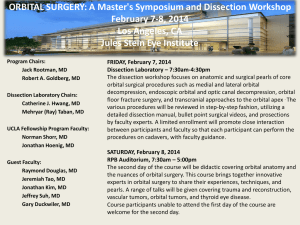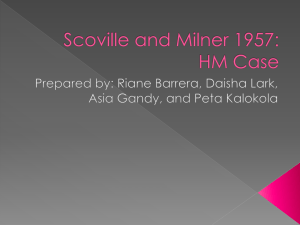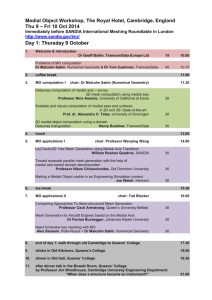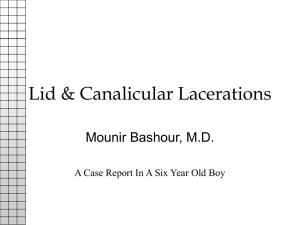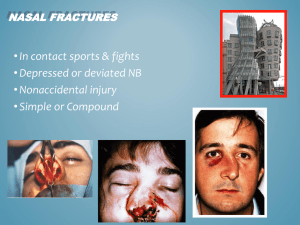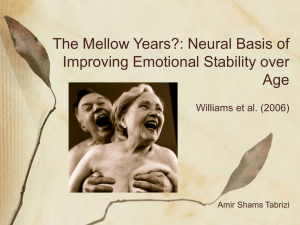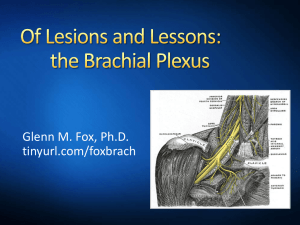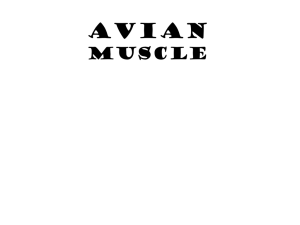NOE Fixation
advertisement
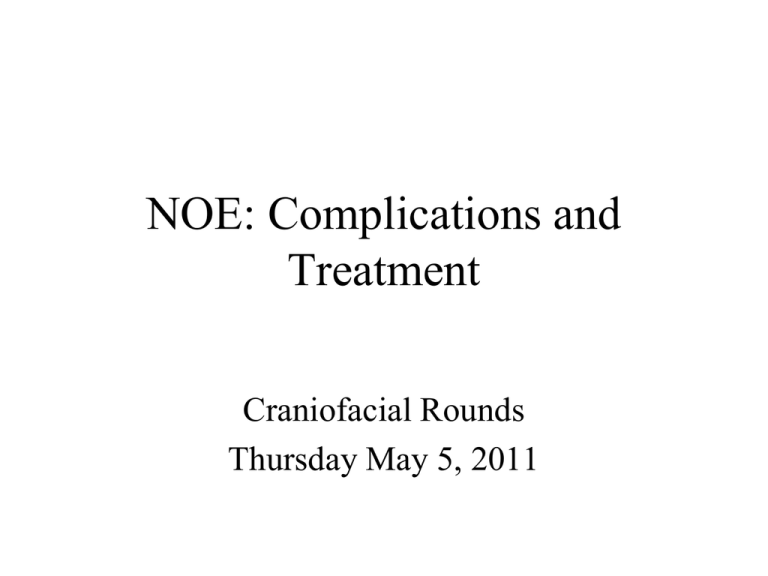
NOE: Complications and Treatment Craniofacial Rounds Thursday May 5, 2011 Anatomic considerations • Medial canthal tendon • Bones: frontal, nasal, maxilla, lacrimal, ethmoid – Medial orbital wall or orbital floor fractures – Anterior cranial fossa • Vessels: Supraorbital, supratrochlear, infratrochlear, anterior and posterior ethmoidal arteries • Eye: Globe, optic nerve • Lacrimal apparatus – Cannaliculi Diagnosis • CT • Old photographs – Estimate intercanthal distance Physical Exam • Swelling • Intercanthal distance – Approx half interpupillary distance – >40 mm • • • • Eyelid traction Bimanual exam CSF rhinorrhea Eye exam – Enophthalmos – 20-25% ocular injury Facial Deformity • • • • Telecanthus Shortened palpebral fissures Enophthalmos Shortened/retruded nose – Flattening, collapse, inward telescoping of nasal bones • Ocular dystopia Treatment Indications • All displaced fractures • Medial canthal tendon insertion displacement/ disinsertion – Telecanthus • Facial deformity • Nasal airway • Tear drainage disruption Fixation - Closed reduction, external splinting, wires - Indications - Simple fractures - Pros - Simple - Cons - Cannot correct medial canthal displacement/ disinsertion - Unable to reduce medial orbital wall/rim - Collapse, flattening, telescoping of nose Fixation - Open reduction, internal fixation - Mustarde 1964, Dingman 1964 - Medial canthal tendon insertion - Stranc 1970 - Canthopexy - Suture/wire Approaches • Approaches – Existing lacerations – Local incisions • Midline vertical (Stranc) • Open sky (Converse 1970) • W incision – Coronal incision – Lower lid incision – Upper gingivobuccal sulcus incision Repair 1. 2. 3. 4. 5. 6. 7. 8. Bony rim exposure MCT insertion exposure Reduction medial orbital rim Reconstruction medial orbital wall MCT canthopexy Septal reduction Nasal dorsum augmentation Soft Tissue Readaption From Ellis JOMFS 1993 1. Bony Rim Exposure • Exposure – Orbital rims – Medial orbital wall • Anterior ethmoidal arteries – cauterize • Posterior ethmoidal arteries – optic nerve just a few mm posterior!! – Nasal bridge • Careful not to detach MCT insertion – MCT • ID fragment of insertion 2. MCT Insertion Exposure • MCT insertion 3. Reduction Medial Orbital Rim • Reduce/recon medial orbital rim – Transnasal reduction of MCT-bearing bone fragment – Simple • Transnasal wiring - A: Coronal view, horizontal mattress - B: Improper placement (too anterior, lateral displacement) - C: Proper placement From Ellis JOMFS 1993 4. Reconstruction Medial Orbital Wall • Alloplastic – Titanium mesh, medpor • Autologous – Bone (rib, calvarium 5. MCT Canthopexy 6. Septal Reduction – Asch forceps 7. Nasal Dorsum Augmentation Dorsal nasal support to prevent secondary deformities • Primary bone grafting • Indicated with a severely comminuted septum • Risks dorsal support weakness 8. Soft Tissue Readaption – Recreate the naso-orbital “valley” – Stents or bolsters – Transnasal wiring for comminuted/severe cases Conclusion • NOE – complex anatomy • Secondary deformities difficult to treat • Early repair, ORIF • Restoration of intercanthal width • Proper reduction of canthal tendon bearing fragment – Early bone grafting to prevent secondary deformity


